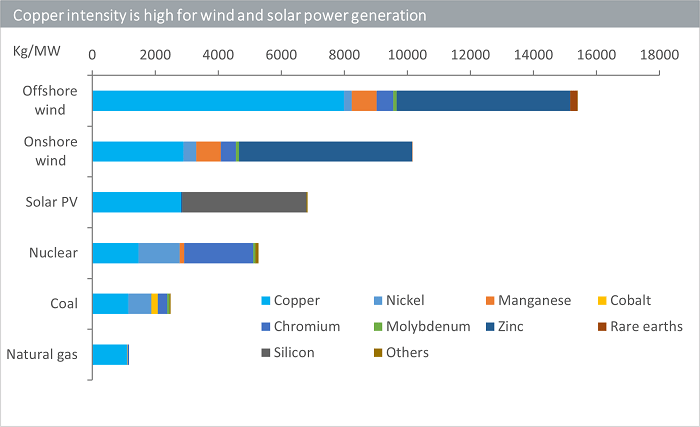Copper is one of the few elements that has been used by humans for over 10,000 years. Archaeological evidence suggests that copper was first discovered and utilised by ancient civilisations as early as 9000 BCE1. Its malleability, durability, and excellent conductivity made it highly prized for tools, weapons, and decorative objects. Copper’s rich history as a valuable and versatile metal showcases its enduring significance and timeless appeal.
Today, copper’s importance in the global economy continues to rise, especially given the boom in renewable energy. Copper is an excellent conductor of electricity, making it an ideal material for renewable energy systems. Its high electrical conductivity allows for efficient energy transfer, minimising power losses during transmission and distribution. Moreover, copper’s unparalleled malleability and ductility, which refer to its ability to be easily shaped and stretched without breaking, make it incredibly challenging to substitute with other materials.
High intensity in wind and solar
Today, wind and solar are among the most mainstream forms of renewable energy. The figure below shows how much more copper is required when generating power from offshore wind (wind turbines in the seas), onshore wind (wind turbines on land), and solar photovoltaic (PV) compared to fossil fuels like coal and natural gas.

Source: IEA, Minerals used in clean energy technologies compared to other power generation sources, IEA, Paris https://www.iea.org/data-and-statistics/charts/minerals-used-in-clean-energy-technologies-compared-to-other-power-generation-sources, IEA. Licence: CC BY 4.0. October 2022.
Forecasts are not an indicator of future performance and any investments are subject to risks and uncertainties.
Copper is extensively used in wind turbines. It is employed in generator coils, transformers, and electrical cables. The strong magnetic properties of copper enable efficient power generation and ensure reliable performance in wind turbine systems. Copper is also a crucial element in solar panels. It is used in the wiring, busbars2, and connectors within the panels. Copper’s excellent electrical conductivity facilitates the efficient conversion of sunlight into electricity and supports the overall performance of solar energy systems.
For the power generated from renewables to ultimately be deployed effectively, electrical grid infrastructure and energy storage are also needed. Copper, once again, is integral in building both. In energy storage systems, which complement renewables by storing energy for days when the wind isn’t blowing or the sun isn’t shining, copper is used in batteries and supercapacitors3. It is utilised in the conductive components, such as electrodes and current collectors, enhancing the efficiency and durability of energy storage devices. In electrical grid infrastructure, copper is extensively used in power cables, transformers, and distribution systems, ensuring the reliable transmission of electricity from renewable sources to end consumers.
Doing it sustainably
Copper is deemed to have infinite recyclability. This means that the metal does not lose any of its properties and can be used again and again. Recycled copper requires 85% less energy than primary production4. This highlights the huge environmental benefit of recycling the commodity.
Today, roughly a third of total copper production comes from recycling. This means that, as we scale up renewable energy, we must also bolster the recycling industry. Copper’s infinite recyclability will make that a fruitful endeavour.
The irreplaceable metal
In conclusion, copper stands as an irreplaceable raw material for renewable energy. Its exceptional electrical conductivity, second only to silver, positions copper as the ideal choice for efficient energy transfer in wind turbines, solar panels, energy storage systems, and electrical grid infrastructure. As the world embraces renewable energy on a larger scale, the demand for copper will continue to grow. And given its infinite recyclability, if the world deploys its resources appropriately, this growth can be sustainable.
Sources
1 Copper Development Association.
2 A busbar is a rigid conductor used for connecting several circuits.
3 Supercapacitor is an electronic device that store large amount of electric charge.
4 Copper Alliance.

